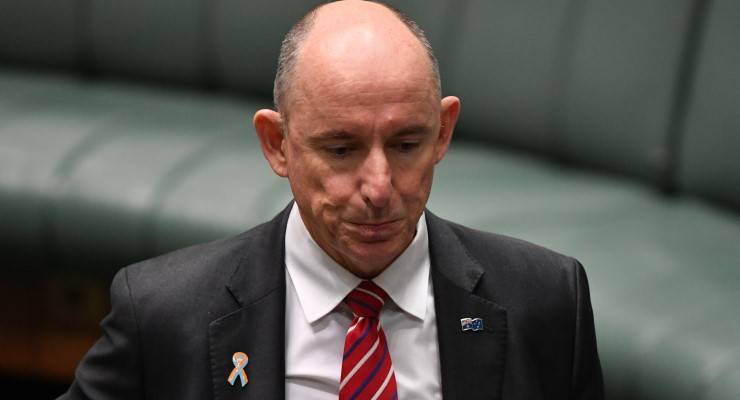
The Twitter effect
It’s depressingly common to hear about the diminished power of the media — at least, according to the… um… media — but evidently some people are still rightfully fearful of it.
For example: the website of investigative journalist Michael West has been busily running a series called “QED: The Case for a Federal ICAC” which has been shining a light on some of the more questionable acts by our federal politicians.
One archival story which was given a push on the socials was about Minister for Government Services Stuart Robert and the curious story of Robert International, a private investment company which benefited from millions in government contracts, and whose directors were Roberts’ parents. That last bit was, it turned out, exciting news to Roberts Sr.
This story is a couple of years old, and yet when West re-pushed it on Twitter this week he was surprised to discover that his account was removed shortly thereafter. Similarly surprised were his thousands of followers, who proceeded to share the story around to the extent that Stuart Robert found himself a trending topic in a textbook example of the Streisand Effect. Whoopsie!
The ban was reversed a few hours later with the tweet reinstated, with no explanation forthcoming. West seemed to have a theory as to what happened: “Seems to have been a short ban. No explanation by Twitter so far. Assume somebody has paid a lawyer to write a letter. Twitter has caved in before — on a lawyer’s letter — without checking the facts.”
Here’s hoping other politicians follow this example and attempt to suppress unwelcome investigations into their activities. It’s a valuable way of getting traffic numbers up.
Great Barrier Beef
Speaking of hit political stories from 2018, remember the Great Barrier Reef Foundation — the unknown charity which magically received an abrupt, no-tender $444 million dollar grant from the Turnbull government despite being a largely unknown private foundation with links to the fossil fuel industry?
Well, you’ll be delighted to know that it’s been hard at work raising money for as-yet-unspecified reef-related things through fundraising efforts and donations.
Indeed, at the time then-environment minister Josh Frydenberg insisted to Insiders host Barrie Cassidy that the reason this piddling, almost-half-a-billion-dollar grant went to the foundation and not one of the other, more active organisations attempting to rescue the dying natural wonder was because “it is the best organisation to leverage [donations] off the private sector”.
The foundation concurred, releasing its investment strategy which included a goal of raising $357 million in private sector dollars by 2022-23. And how’s that been working out? Glad you asked!
Or, more specifically, glad The Guardian asked: “The foundation said it had raised $21.7 million in in-kind donations from research and project partners, about 6% of the total $357 million target,” The Guardian explained. “It has raised none of the $100 million from the capital campaign and refused to provide any figures to show how it was tracking towards targets for corporate giving and individual donations.”
And while we’re certain those “in-kind donations” are very valuable and absolutely exist, we can’t help noticing that the current return on investment isn’t far above what they’d have gotten if they’d just put the entire grant into a high interest savings account. Way to leverage the heck off that private sector, guys.
Nautical distancing
As the world’s borders remain largely locked, there has been plenty of genuine concern about people trapped overseas and trying to get home, and much genuine fury about people trapped at home and wanting a goddamn holiday somewhere other than their laundry.
But spare a thought for avant-garde musical artistes who picked a very, very bad time to create a floating live-music-visual-projection-project-thing and go on a year-long sea voyage playing in areas most threatened by climate change.
The electro-art duo Filastine and Nova set sail last September from Rotterdam in the Area Kinari, a ship decked out as a seaworthy, low-emission floating art-performance space, with a multinational crew of collaborators and a plan to take their live show to communities along a path winding from the Netherlands to Indonesia.
And that worked out pretty well for the first few months, and then went extremely wrong in March as the world’s ports started closing to business, recreational and anti-pollution art statement travel alike.
The “multinational” bit of the plan was a particular challenge because even the ports that did allow them to dock — like Hawaii, where an American crew member jumped ship — wouldn’t allow the non-citizens to stay indefinitely.
So they’ve been hopping along ever since, right through the northern hemisphere’s hurricane season, aside from that two month period where they were largely adrift in the Pacific and had to be saved by a Chinese fishing boat.
Right now they’re reportedly sheltering on Guam with rapidly expiring emergency visas and keeping alive via their Patreon subscriptions. Assuming they survive, their inevitable documentary about all this will be goddamn amazing.








That back-of-the-envelope Barrier Reef $444 million was given with bugger all accountability to some shadowy fossil fuel mates, to do something or other to the reef and to solve a short term problem with an undertaking given to the UN. That amount is just shy of half of the ABC budget and illustrates the level of loathing this mob have for our much loved old Auntie.
Also remarkably similar to the amount gifted to the War Memorial to build it Disneywar theme park.
After knocking down the Anzac Hall – which is too old, having been built in 2001.
Regards pathetic Mossad shill & dishonourable Stuart Robert, he’s just a victim of his own success extremely backhandy at doing favours 4 Nimrod Resources scale corporates & thus the major link 2 federal Liberal party donations in a game of golfing political graft pay 2 play style reciprocal backscratching arrangements whereby the chief source of private individual donations has a verifiable proclivity for cheating (ultimately himself !!) especially when traversing those tight unforgiving Huntingdale GC fairways but speaking of infamous cheats who are also wannabe cheiftains who can forget that $444m most dubious of “Captain’s Call” made by Captain Mal Bligh just b4 his prearranged mutiny, bags packed for a staged exit allowing the two main co conspirators who helped facilitate the outrageous GBReefF lump sum fraud in broad daylight all done brazenly without a busness plan but gotta remember Prof Peter Ridd’s expert remarks on the actual health status of the GBReef as “very good condition” so unsurprising to learn by serendipitous happenstance that even the altrustic basis of need spruiked for the lump sum being a “dying GBReef” in dire need of quick injection of $444m lump sum budgeted allocations from Frydenberg’s Dept of Energy/Environment cash direct to the GBReef Foundation that research of the old website befire wholesale amendments indicated to be less “charity” & moreso Goldman Sachs Green Bond money laundering front but that would be just pure speculation lest forgetting to remind the not insignificant detail that Captain Mal Bligh was CEO of the Australian affiliate branch 4 same which allows the lid to fit neatly on that little box of under reported amazing coincidences linked to the $444m brazen fraud such that hope springs eterrnal that the ultimate justice dealt to these deep state crooks & cronies in the not too distant future will lean heavily on a major contribution from the Master Guillotine Makers Guild of the Grand Orient & Greater Terra Australis but only time will tell if I’m right.
Dear Andrew P Street – Hmm yes the Twitter effect, never mind the lawyers, ask the Ethicist.
@twitterau regularly shadow ban this important story without notice, without notification and with apparent impunity re S Longstaff & Ethics Centre swearing on oath in vital court documents to multiple claims they knew were not true – please see letter Ethics Centre Board https://bit.ly/2uTMYNH
On Twitter now you see it now you don’t – but the screen shots show the way – ask The Ministry of Ethics.
Oh btw and by coincidence ex @twitterau exec @edstjohn2 is now GM at Ethics Centre
Over the years respected journalists have checked the corro and commented – Simon, why not resolve this? Wendy Bacon, Michael West, David Donovan, Independent Australia